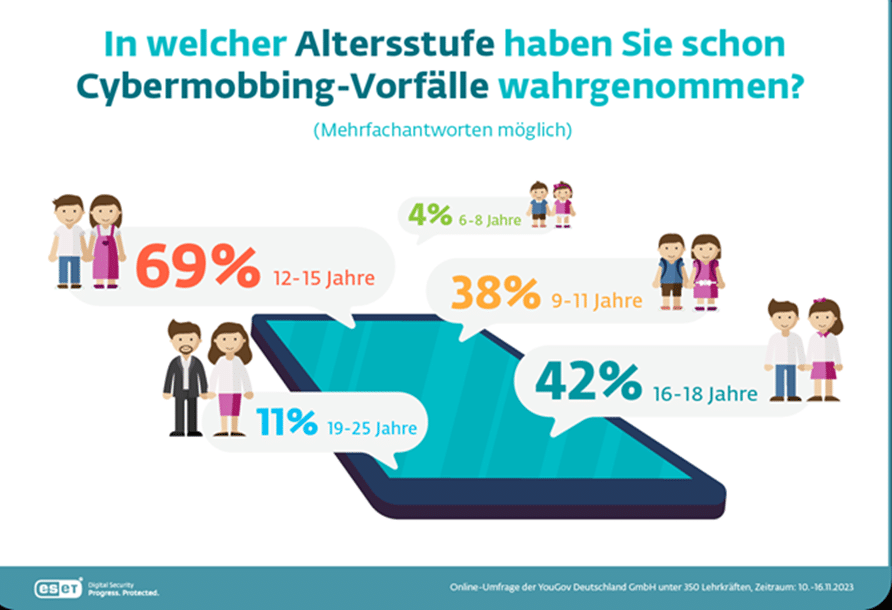This form of digital harassment, which once primarily affected young people, is showing a worrying presence in German primary schools, according to a recent study by YouGov, carried out on behalf of IT security manufacturer ESET.
Cyberbullying
While the digital world offers endless possibilities, it also presents challenges such as cyberbullying . This phenomenon, in which individuals are harassed, threatened or humiliated through digital channels such as social media, messaging apps and online platforms, is becoming increasingly important in the educational landscape.
Overview of the YouGov study commissioned by ESET
The extensive survey, carried out by YouGov, provided insight into the experiences and observations of teachers at different types of schools, including primary, special, secondary and secondary schools as well as high schools. A total of 350 teachers were surveyed about their experiences and observations regarding cyberbullying.

Development of cyberbullying in schools
Interestingly, the study showed that cyberbullying is slightly more prevalent in primary schools than in secondary schools such as high schools and secondary schools. This trend has been observed by teachers over the last two to three years, with each child potentially being both a victim and a perpetrator.
Effects of cyberbullying on students
Cyberbullying has a profound impact on young people, particularly primary school students. The YouGov study reveals that a significant number of primary school students are affected by cyberbullying, with the proportion of girls affected being over 50% and that of boys reaching as high as 80%. This suggests a widespread problem that can have serious psychological consequences for the children affected, including anxiety, depression and reduced self-esteem.
Role dynamics between victims and perpetrators
A particularly worrying aspect of cyberbullying is the fact that children can be not only victims but also perpetrators. In many cases, bullying cannot be attributed to a specific gender, highlighting the complexity of the problem. Bullying actors often come from the victim's immediate environment, such as their own class, which makes the situation even more difficult for the child affected.
Prevention strategies and need for action
Existing measures and their effectiveness
Schools have taken various measures to combat cyberbullying, including education and prevention programs. However, the study shows that primary schools take fewer preventative measures compared to other types of schools. This highlights the need for increased efforts in this area.
Recommendations for action for schools and teachers
It is critical that schools and educators take proactive steps to prevent and respond to cyberbullying. This includes:
- Increasing attention and awareness of the problem.
- Establish clear policies and procedures for reporting and addressing cyberbullying incidents.
- Promote open communication between teachers, students and parents.
- Integrating cyberbullying prevention into the curriculum.
FAQs: Cyberbullying in elementary schools
What is cyberbullying and how is it different from traditional bullying?
Cyberbullying refers to the harassment, threat or humiliation of a person via digital media such as social networks, messaging apps or online forums. Unlike traditional bullying, which involves physical contact or verbal insults, cyberbullying is digital and can take place 24 hours a day, often anonymously.
How common is cyberbullying in elementary schools?
According to YouGov research commissioned by ESET, cyberbullying is a growing problem in primary schools. About 51% of elementary schools reported cyberbullying cases. This number shows that younger children are also increasingly affected by digital bullying.
What role do teachers and parents play in preventing cyberbullying?
Teachers and parents play a crucial role in preventing cyberbullying. Teachers can educate, promote a culture of openness, and establish clear rules and procedures for dealing with bullying. Parents can educate their children about the risks, provide a listening ear for their concerns and work with the school if necessary.
How can elementary school students be protected against cyberbullying?
Elementary school students can be protected through education, awareness and active surveillance. Schools and parents should educate children about the dangers of the Internet and teach them how to stay safe online. It is also important that children are encouraged to talk about cyberbullying they have experienced.
What can schools do to combat cyberbullying?
Schools can combat cyberbullying by:
- Integrate educational programs and prevention measures into the curriculum.
- Create a safe and supportive environment where students feel comfortable reporting bullying.
- Establish clear policies and consequences for cyberbullying.
- Collaborate with parents and communities to create a comprehensive support network.
For more reports and analysis, subscribe to our newsletter at Newsletter and sign up for our monthly online lectures and workshops at Workshops . Stay informed and critical!
Also read:
Notes:
1) This content reflects the current state of affairs at the time of publication. The reproduction of individual images, screenshots, embeds or video sequences serves to discuss the topic. 2) Individual contributions were created through the use of machine assistance and were carefully checked by the Mimikama editorial team before publication. ( Reason )

